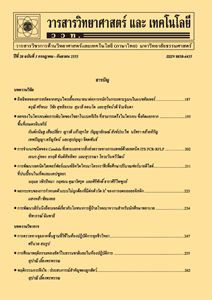คุณค่าทางโภชนาการของไข่ที่นิยมบริโภคและผลของการประกอบอาหาร
Main Article Content
Abstract
บทคัดย่อ
ไข่เป็นแหล่งของสารอาหารโปรตีนคุณภาพดีที่นิยมบริโภคในทุกประเทศ งานวิจัยนี้จึงศึกษาถึงคุณค่าทางโภชนาการของไข่ที่นิยมบริโภค 3 ชนิด คือ ไข่ไก่ ไข่เป็ด และไข่นกกระทา โดยสุ่มเก็บตัวอย่างไข่ดังกล่าวจากตลาด 3 แห่ง ในกรุงเทพมหานคร ตลาดละ 3 ร้านค้า นำไข่แต่ละชนิดจากแต่ละตลาดมาเตรียมเป็น single composite sample แบ่งไข่ทั้งหมด เป็นไข่ดิบ และไข่ที่จะนำไปประกอบอาหารตามวิธีที่นิยมบริโภค ได้แก่ การต้ม เจียว หรือทอด และตุ๋น (เฉพาะในไข่ไก่) ศึกษาขนาด yield factor ปริมาณส่วนที่กินได้ (edible portions) และคุณค่าทางโภชนาการในเรื่องของสารอาหารหลัก โคเลสเตอรอล กรดไขมัน เกลือแร่ และวิตามิน (วิเคราะห์โดยวิธีมาตรฐาน AOAC) นอกจากนี้ยังศึกษา % true retention ของวิตามินต่าง ๆ ที่ผ่านกระบวนการหุงต้ม ผลการศึกษา พบว่าไข่ดิบทั้ง 3 ชนิด มีปริมาณโปรตีนไม่แตกต่างกัน (13-14 กรัม ต่อ 100 กรัม) ไข่เป็ดมีปริมาณไขมันและโคเลสเตอรอลสูงสุด (12 กรัม และ 555 มิลลิกรัม ต่อ 100 กรัม ตามลำดับ) เมื่อเทียบกับไข่ชนิดอื่น ไข่ต้มหรือไข่เจียวจากไข่ไก่ และไข่เป็ด 1 ฟอง (หนึ่งหน่วยบริโภค) จัดได้ว่าเป็นแหล่งที่ดีของโปรตีน ฟอสฟอรัส วิตามินเอ ไรโบฟลาวิน และ โฟเลต ซึ่งคิดเป็นร้อยละ 10-20 ของปริมาณที่แนะนำให้บริโภคต่อวัน (Thai RDI) ในขณะที่ไข่นกกระทา ต้ม หรือ ทอด หนึ่งหน่วยบริโภค (4 ฟอง) ให้พลังงาน และโปรตีนน้อยกว่าเล็กน้อย แต่อุดมไปด้วยวิตามินเอและโฟเลต (คิดเป็นร้อยละ 20-25 ของปริมาณที่แนะนำให้บริโภคต่อวัน) และมีโคเลสเตอรอลน้อยกว่ามาก การต้มหรือเจียวไข่ไก่และไข่เป็ดไม่มีผลต่อปริมาณไทอะมีน และไรโบฟลาวิน โดยมีค่า % true retention มากกว่า 90 % ในขณะที่มีการสูญเสียปริมาณวิตามินเอปานกลาง (15-30 %) และโฟเลตเล็กน้อย การตุ๋นไข่ไก่พบว่ามีการสูญเสียของวิตามินเอถึง 50 % การต้มหรือทอดไข่นกกระทาในถาดหลุมมีการสูญเสียของปริมาณวิตามินเอน้อยกว่า โดยมีค่า % true retention เท่ากับ 90 และ 85 % ตามลำดับ และมีผลลดระดับของไทอะมิน ไรโบฟลาวิน และโฟเลต 10-25 % ของระดับตั้งต้น โดยสรุป การประกอบอาหารประเภทไข่ตามวิธีที่นิยม สามารถรักษาคุณค่าทางโภชนาการของสารอาหารหลัก และวิตามินที่สำคัญ โดยมีการสูญเสียของวิตามินเอบางส่วนจากการต้ม เจียว หรือตุ๋น
คำสำคัญ : คุณค่าทางโภชนาการ; ไข่; การต้ม; การทอด; การตุ๋น
Abstract
As a source of high-quality protein, eggs are consumed in all countries. The purpose of this research was to study the nutritive value of commonly consumed eggs. Hen, duck and quail eggs were purchased from three local markets in Bangkok, Thailand. At each market, eggs were purchased from three shops and combined into a single composite sample. They were divided into uncooked fresh eggs and cooked eggs by boiling, frying or steaming (hen eggs only). The size, yield factor, edible portion, nutritive value in terms of proximate composition, cholesterol, fatty acids, minerals and vitamins (using AOAC standard methods) contents of the eggs were measured. Percentage of true retention of some vitamins after cooking was also evaluated. The results showed that protein content of all fresh eggs was no significant difference (13-14 g/100 g). Duck eggs contained higher levels of lipid and cholesterol (12 g and 555 mg/100 g, respectively) than hen or quail eggs. One hen or duck egg (one serving), prepared by boiling or as an omelet, is considered to be a good source of protein, phosphorus, vitamin A, riboflavin and folate as it provides 10-20 % of the Thai Recommended Daily Intake (Thai RDI) for these nutrients. One serving of boiled or fried (in mold) quail eggs (4 eggs) provide slightly lower amounts of energy and protein than hen or duck eggs. However, they are rich sources of vitamin A and folate (20-25 % of Thai RDI) and contain much less cholesterol. Thiamin and riboflavin were not significantly affected by boiling or frying, more than 90 % true retention was observed. However, moderate loss of vitamin A (15-30 %) and slight loss of folate occurred in boiled or fried hen and duck eggs, and about 50 % of vitamin A was lost in steamed hen eggs. Boiling or frying (in a mold) quail eggs had less effect on loss of vitamin A and 90 and 85 %, respectively. The cooking reduced thiamin, riboflavin and folate 10-25 % of the original levels. In conclusion, commonly household methods for cooking eggs preserve their nutritive value in terms of the main nutrients and significant vitamins, with some loss of vitamin A by boiling, frying or steaming.
Keywords: nutritive value; eggs; boiling; frying; steaming


